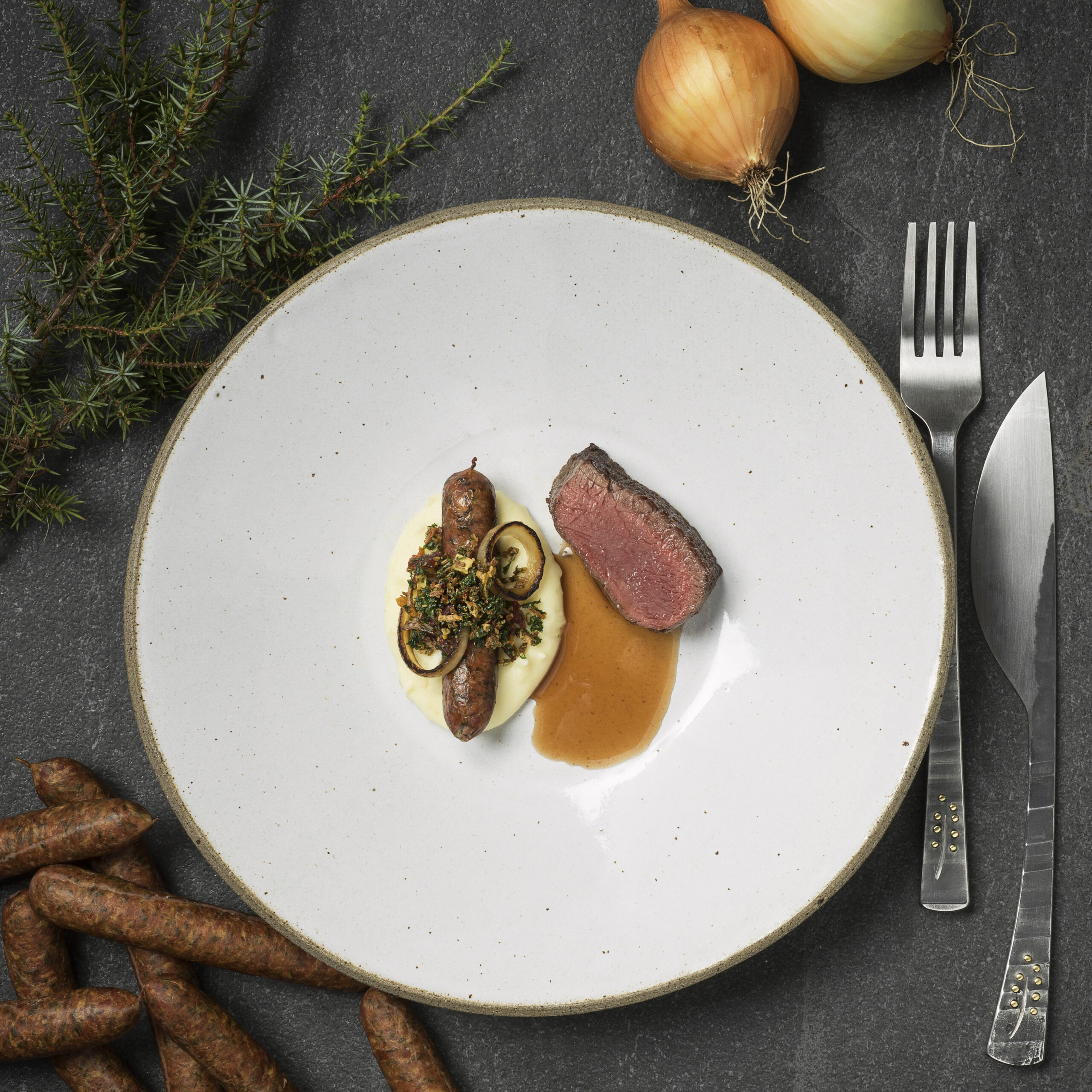
Starter
Fish soup with pike-perch from Lake Hjälmaren and carrots from Stora Mellösa
Our pike-perch is fished from the blue waters of Hjälmaren to the east. For centuries, this local fish has been appreciated as a delicacy and exported to Sweden’s capital along with crayfish and other produce from the beautiful waters of the lake. The water level of the Hjälmaren was lowered more than a hundred years ago, creating new farmland. This fertile soil on the plains of Stora Mellösa was soon covered in proud rows of carrots and potatoes. The soup brings together the pike-perch from the shining lake and the carrots from the former seabed, on a plate whose edge is reminiscent of the ploughed furrows in the soil of Närke.

Main course
Wild skomakarlåda: A saddle of venison and smoked venison sausage with a smooth potato purée, sweet and sharp cranberries and crisp root vegetable sprinkles. A new take on the traditional skomakarlåda, a dish of beef and mashed potatoes which translates as “shoemaker’s box”.
Fallow deer thrive in the forests of Närke and Hallsberg is said to be the municipality in Sweden with the largest fallow deer population. In the autumn, fallow deer produce a dark meat – nothing like as dry as the sole of a shoe. In this version, a saddle of venison and smoked venison sausage are served naturally with a smooth potato purée, sweet and sharp cranberries and crisp root vegetable sprinkles.
Oxen and horses worked hard pulling iron, coal and seed in the winter, often with a Närke farmer urging them on. They transported cargo back and forth between ironworks, fertile farmland and the market squares and ports of the towns. Their hides were tanned to make leather, and the leather was used to make shoes in Närke, known for its many shoemakers. Our take on skomakarlåda is a tribute to all the people who worked in the shoemaking industry.

Dessert
Närke crème brûlée: Ice cream flavoured with cowslip honey, wheat as a creamy base, crowned with hazelnut biscuits
The cowslip is the flower of Närke. In the spring, the meadows are yellow with this sweet-smelling flower that attracts spring bees. Ice cream flavoured with cowslip honey sets the tone for the last act of our meal. In the golden evening light of late summer, the wheat sways in the breeze in the fertile fields of the Närke plains. Here wheat becomes the base for a creamy brûlée.
The hazel thicket rustles, the little hazel mouse is Närke’s provincial animal. Here we have used hazelnuts to represent it in our dessert. Örebro was famed for its biscuit factory and a hazelnut biscuit is the crowning finishing touch.
Närke, small and flat with fertile soil and lakes overflowing with fish, surrounded by forests and iron-rich mountains. What does Närke taste like? Amazing! But a Närke meal experience is more than food. It’s about flavours that have grown out of the landscape. It’s the colours, materials and patterns that remind us of Närke’s history and local ingredients.
The people behind the menu
Concept and recipes
Starter: Roger Hjälm, Katrinelund Gästgiveri & Sjökrog and Davide Lindqvist, Krogen som inte finns.
Main course: Anders Johnsson, CVköket and Joe Devine.
Dessert: Niklas Edgren, Egastronomi and Lena Karlsson, Sött och Salt.
Project management
County Governor Maria Larsson, Henrik Scander, Restaurant and Culinary Arts, Campus Grythyttan, Örebro University, Åsa Lindin, County Administrative Board.
Beautifully presented
The pattern on the cloth with ears of grain from the soil of Närke comes from a wood block carved by block printer Fredrik Sundström, born in Stora Mellösa in 1815. The fabric was printed by the small textile printing works in Kumla. Ears of grain also take pride of place in Fredrik Spåre’s rustic steel cutlery, reminding us that iron and the art of blacksmiths is part of Närke’s history.
The ceramics for the starter are made by Susanne Ivarsson from Käramik Av Si. Camilla Pahlstad from Milla Keramik threw the plates for the main course and the dessert. The drinks, chosen by Henrik Scander, come both with and without alcohol and are imbibed from Nina Christensen’s fluidly designed glasses – A material in motion, BLANK. Knives, Fredrik Spåre, Spåres knivar.
Photos: Andreas Hylthén.
To drink
Aperitifs:
Gibson with pickled onion from Kilsbergen Gin
Spiced smooth juniper infusion with Karintorp tomatoes
Starter:
Örebro Bitter from Närkes kulturbryggeri and a cool rosehip drink with a hint of carrot
Main course:
Warm Oolong tea, flavoured with a clear mushroom bouillon. Tzolkin rum from Bergslagens Destilleri can be added if desired
Dessert:
Grythyttan Hjortron, cloudberry dessert wine from Grythyttans vineri, Apple and cloudberry drink with hibiscus